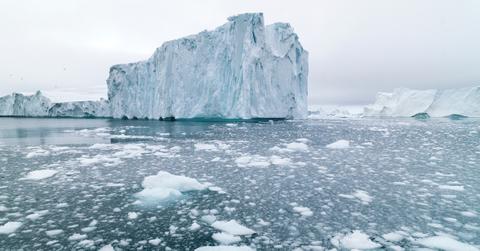All the Sea Ice Surrounding Alaska Has Melted — Here's What It Could Mean
Melting ice and rising sea levels could have dire consequences.
Updated Aug. 7 2019, 3:40 p.m. ET

Sea ice in Alaska is melting faster than ever before. As reported by The Independent, Alaskan climate specialist at the Alaska Centre for Climate Assessment and Policy Rick Thoman shared the alarming news on Twitter earlier this week. According to Thoman, all the ice within 150 miles of Arctic water surrounding Alaska has completely melted. The alarming melting rate is a result of July's sweltering hot weather, with rising temperatures strongly linked to the climate crisis.
"Alaska waters now completely clear of sea ice as last ice in the Beaufort Sea offshore Prudhoe Bay melted away," Thoman tweeted on Aug. 4. "The closest ice to Alaska is now about 150 miles (240km) northeast of Kaktovik."
As Mashable pointed out, this is not the first time Alaska's waters have been completely free of ice — in fact, just two years ago, in the summer of 2017, the same thing happened. But what's notable is that during the 2017 melt season, the ice melted much later in the summer. "It's cleared earlier than it has in any other year," Thoman told Mashable.
The ice is expected to re-form in the fall — however some experts are worried that this year's particularly strong melting rate could delay that. “I have to wonder how much it’s going to affect and delay freeze up this fall,” Zack Labe, a climate scientist at the University of California Irvine told Motherboard last week. “There’s so much open water.”
Labe also explained to Motherboard that the rapid melting this year is just a part of the larger picture of the climate crisis. As the outlet pointed out, Arctic temperatures are rising at double the rate of the global average — and if that rate continues, the world could be in serious trouble.
Peter Wadhams, a professor of Ocean Physics at the University of Cambridge, spoke with The Independent about the issue. “At this time of year ‘normally’ (i.e. 30 years ago) there would be sea ice in southern Alaska waters but, more importantly, sea ice across the north coast of Alaska leaving only a narrow slot between ice and land for ships attempting a northwest passage," he told the outlet. “The latest shrinkage is part of an Arctic-wide phenomenon which is leading towards an ice-free summer as the future norm.”
So if this really is the new norm for summers in Alaskan waters, what does this mean? For one thing, melting ice caps means ocean water is expanding, which means sea levels are rising. As explained by National Geographic, rising sea levels can have a number of consequences, such as erosion, soil contamination, loss of habitat for sea animals, birds, and plants, and stronger natural disasters like hurricanes and typhoons. Additionally, the less ice there is on Earth, the more heat the Earth will absorb from the sun — further warming the globe, as explained by Carbon Brief.
Alaska's waters are not the only place experiencing abnormal melting this summer. A few weeks ago, an alpinist trekking the French Alps noticed that so much snow melted on the top of a mountain in response to Europe's massive heatwave, that a lake had actually formed.